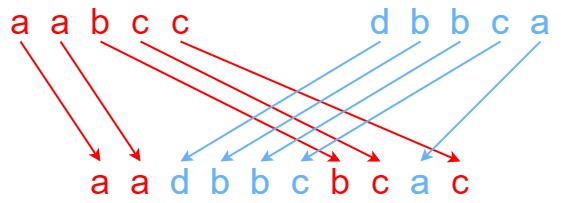Given strings s1, s2, and s3, find whether s3 is formed by an interleaving of s1 and s2.
An interleaving of two strings s and t is a configuration where s and t are divided into n and m
substrings
respectively, such that:
s = s1 + s2 + ... + snt = t1 + t2 + ... + tm|n - m| <= 1- The interleaving is
s1 + t1 + s2 + t2 + s3 + t3 + ...ort1 + s1 + t2 + s2 + t3 + s3 + ...
Note: a + b is the concatenation of strings a and b.
Example 1:
Input: s1 = "aabcc", s2 = "dbbca", s3 = "aadbbcbcac" Output: true Explanation: One way to obtain s3 is: Split s1 into s1 = "aa" + "bc" + "c", and s2 into s2 = "dbbc" + "a". Interleaving the two splits, we get "aa" + "dbbc" + "bc" + "a" + "c" = "aadbbcbcac". Since s3 can be obtained by interleaving s1 and s2, we return true.
Example 2:
Input: s1 = "aabcc", s2 = "dbbca", s3 = "aadbbbaccc" Output: false Explanation: Notice how it is impossible to interleave s2 with any other string to obtain s3.
Example 3:
Input: s1 = "", s2 = "", s3 = "" Output: true
0 <= s1.length, s2.length <= 1000 <= s3.length <= 200s1,s2, ands3consist of lowercase English letters.
Follow up: Could you solve it using only O(s2.length) additional memory space?
class Solution:
def isInterleave(self, s1: str, s2: str, s3: str) -> bool:
m, n, o = len(s1), len(s2), len(s3)
if m + n != o:
return False
dp = [[False] * (n + 1) for _ in range(m + 1)]
dp[0][0] = True
# populate the base condition using only s1
for i in range(1, m + 1):
dp[i][0] = dp[i - 1][0] and s1[i - 1] == s3[i - 1]
for j in range(1, n + 1):
dp[0][j] = dp[0][j - 1] and s2[j - 1] == s3[j - 1]
for i in range(1, m + 1):
for j in range(1, n + 1):
dp[i][j] = (dp[i - 1][j] and s1[i - 1] == s3[i + j - 1]) or \
(dp[i][j - 1] and s2[j - 1] == s3[i + j - 1])
return dp[m][n]- O(m * n), where
mis the length ofs1andnis the length ofs2. We iterate over all states (i.e., pairs(i, j)) to fill the DP table.
- O(m * n) for the DP table. We can optimize this to O(min(m, n)) by only keeping the current and previous rows (or columns) if
s2is shorter.
class Solution:
def isInterleave(self, s1: str, s2: str, s3: str) -> bool:
# Check if the total lengths are mismatched, if so, it cannot be interleaved to form s3.
if len(s1) + len(s2) != len(s3):
return False
# If s2 is longer than s1, swap them to minimize the space used in DP.
if len(s2) > len(s1):
s1, s2 = s2, s1
# Initialize the DP array with False values, plus one for zero index (no characters taken from s2).
dp = [False] * (len(s2) + 1)
dp[0] = True # Base case: an empty s1 and s2 trivially form an empty s3.
# Initialize the DP array for the case when s1 is empty.
for j in range(1, len(s2) + 1):
dp[j] = dp[j - 1] and s2[j - 1] == s3[j - 1]
# Iterate through characters of s1
for i in range(1, len(s1) + 1):
# Update dp[0] for the current row, using characters only from s1 up to i
dp[0] = dp[0] and s1[i - 1] == s3[i - 1]
# Iterate through characters of s2
for j in range(1, len(s2) + 1):
# dp[j] is True if:
# 1. dp[j] was True and the next character of s1 matches the corresponding character in s3
# 2. dp[j-1] was True and the next character of s2 matches the corresponding character in s3
dp[j] = (dp[j] and s1[i - 1] == s3[i + j - 1]) or \
(dp[j - 1] and s2[j - 1] == s3[i + j - 1])
# The result for the whole s3 being an interleave of s1 and s2 is found at dp[len(s2)]
return dp[len(s2)]